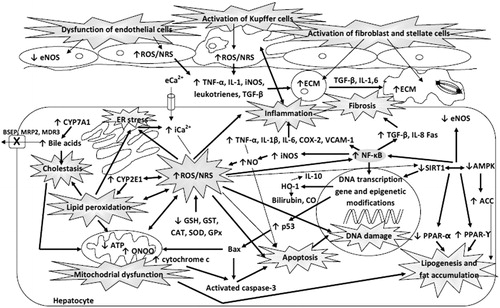Figures & data
Table 1. Most frequently studied hepatoprotective phytochemicals.
Figure 2. The most important multiple pathways in the liver pathobiology that can be interrupted at one or more levels by hepatoprotective plant constituents (not shown) to interfere with oxidative stress. ACC, acetyl-CoA carboxylase; AMPK, adenosine-5′-monophosphate-activated protein kinase; ATP, adenosine triphosphate; Bax, proapoptotic protein of Bcl-2 family; BSEP, bile salt export pump; CAT, catalase; CO, carbon monoxide; COX-2, inducible cyclooxygenase; CYP, cytochrome P450; eCa2+, extracellular calcium; ECM, extracellular matrix; eNOS (NOS-1), endothelial nitric oxide synthase; ER, endoplasmic reticulum; GPx, glutathione peroxidase; GSH, reduced glutathione; GST, glutathione-S-transferase; HO-1, inducible heme oxygenase; IL, interleukin; iCa2+, intracellular calcium; iNOS (NOS-2), inducible nitric oxide synthase; MDR3, multidrug resistance protein 3; MRP2, multidrug resistance-related protein 2; NO, nitric oxide; NF-κB, nuclear factor kappa-B; NRS, nitrogen reactive species; ONOO−, peroxynitrite anion; p53, protein p53; PPAR-α/γ, peroxisome proliferator-activated receptor-α/γ; ROS, reactive oxygen species; SIRT1, silent information regulator T1; SOD, superoxide dismutase; TGF-β, transforming growth factor-β; TNF-α, tumor necrosis factor-α, VCAM-1, vascular cell adhesion molecule-1.


